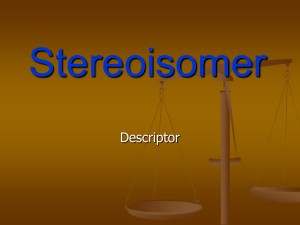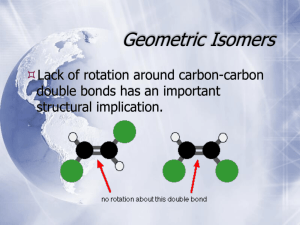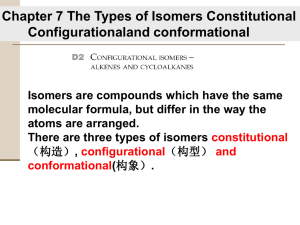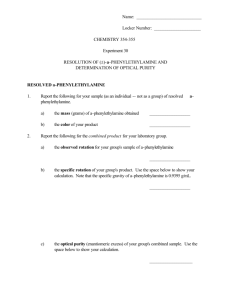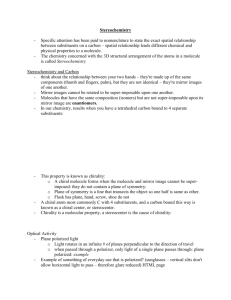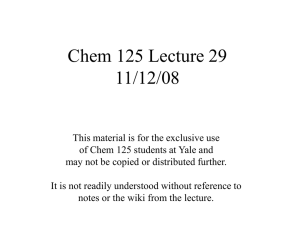5-1 Stereoisomers PPT
advertisement
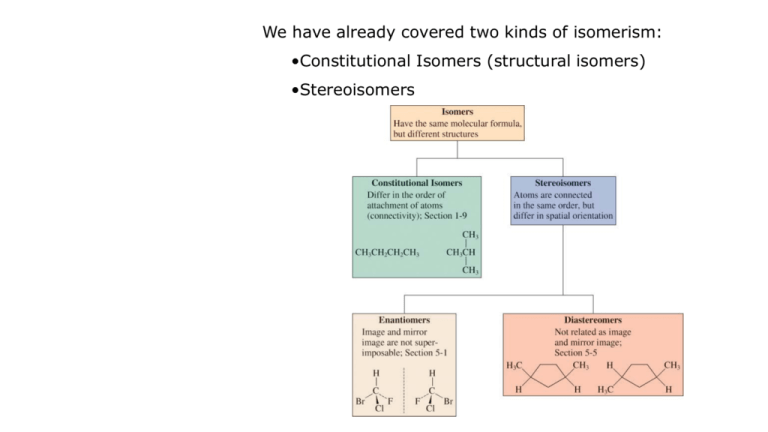
We have already covered two kinds of isomerism: •Constitutional Isomers (structural isomers) •Stereoisomers Examples of Constitutional Isomers: Examples of Stereoisomers: Another type of stereoisomerism is called mirror-image stereoisomerism. Mirror-image related stereoisomers are said to be left-handed and right-handed and occur when a molecule and its mirror image are non-superimposable. 5-1 Chiral Molecules The radical bromination of butane to form 2-bromobutane appears to yield a single product: Chiral molecules cannot be superimposed on their mirror images. The two 2-bromobutane molecules formed by the radical bromination of butane are actually nonsuperimposable and are therefore not identical. A molecule that is not superimposible on its mirror image is said to be chiral. In this case each isomer is called an enantiomer. Compounds whose mirror images are superimposable are called achiral. Examples of chiral and achiral molecules: Above all, the chiral examples contain an atom that is connected to 4 different substituent groups. This atom is called an asymmetric atom or a stereocenter. Often, asymmetric atoms are marked with an asterisk. Molecules having one stereocenter are always chiral. The symmetry in molecules helps to distinguish chiral structures from achiral ones. For most organic molecules, a sufficient test for chirality is absence of a plane of symmetry (mirror plane). A mirror plane is one that bisects the molecule in such a way that the half of the molecule on one side of the plane is the mirror image of the half on the other side of the plane. Methane has 6 planes of symmetry, chloromethane has 3, dichloromethane 2, bromochloromethane 1, and bromochlorofluoromethane none: Optical rotation is measured with a polarimeter. When light is passed through a polarizer, only one of the two perpendicular components of light is passed through. This light is referred to as plane-polarized light. If facing the light source: •Clockwise rotation: enantiomer is dextrorotary (+) •Counterclockwise rotation: enantiomer is levorotary (-) This interaction with light is called optical activity and enantiomers are often called optical isomers. The specific rotation [] of a sample is defined for each chiral molecule (the value is solvent dependent): [ ]t o l c where [ ] = specific rotation t = temperature in degrees Celsius = wavelength of incident light (D = 589 nm, the yellow D line from Na) = observed optical rotation in degres l = sample container length in dm c = concentration (g/ml) Specific rotation is a physical constant for a substance, as is melting point, boiling point, density, etc. Examples of specific rotations: Optical rotation indicates enantiomeric composition. A racemic mixture is a mixture of equal amounts of the + and – enantiomers of a chiral compound. It shows no net rotation of plane-polarized light. When one enantiomer equilibrates with its mirror image, the process is called racemization. When one of the two enantiomers of a chiral compound is present in a mixture in excess over the other, there will be a net rotation of plane-polarized light. A 50% enantiomer excess would be defined as a mixture of 75% one enantiomer and 25% of the other (50%+ with 25%+ and 25%-). The mixture would be called 50% optically pure. The optical purity of an enantiomer is defined: observed % optical purity 100 enantiomer excess


